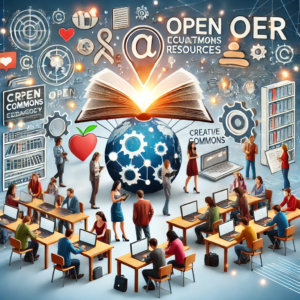Blog Post #4: Open Pedagogy and OER
What is Open Pedagogy?
Open Pedagogy is an educational approach that emphasizes collaboration, student empowerment, and the sharing of knowledge through open educational resources (OER). Unlike traditional teaching methods, which often rely on closed resources and teacher-led instruction, Open Pedagogy encourages students to contribute to the learning process actively. It empowers both students and educators by fostering a participatory and inclusive learning environment where knowledge is co-created rather than merely consumed. Through Open Pedagogy, students can engage in real-world projects, remix and adapt content, and contribute to openly available knowledge.

The Role and Impact of OER
Open Educational Resources (OER) have the potential to transform education by increasing accessibility, reducing costs, and promoting equity. By using OER, students and educators can access high-quality learning materials without financial barriers. In my own learning, OER provides flexibility and the ability to explore diverse perspectives beyond commercial textbooks. Additionally, OER supports educators in adapting and customizing content to meet the specific needs of their students. The widespread adoption of OER can make education more equitable and inclusive, as it ensures that all learners, regardless of socioeconomic background, have access to quality resources.
Global Trends in OER
One of the most impactful global trends in OER is the increasing governmental and institutional support for open access education. Countries like Canada, the United States, and members of the European Union have launched initiatives to promote OER adoption in schools and universities. For example, UNESCO has been advocating for OER as a means to achieve inclusive and equitable education. However, challenges remain, such as disparities in internet access, the need for faculty training, and issues related to content quality and localization. Despite these obstacles, OER presents opportunities to democratize knowledge on a global scale.

Understanding Creative Commons Licensing
Creative Commons (CC) licensing plays a crucial role in the responsible use, adaptation, and sharing of OER. Understanding these licenses helps educators and students navigate the ethical considerations of using open resources while ensuring proper attribution. For instance, a CC BY license allows content to be reused and modified with attribution, while a CC BY-NC-SA license restricts commercial use and requires derivative works to carry the same license. In my work, I might apply Creative Commons licenses when creating open-access study materials, ensuring that others can freely use and adapt them while respecting the original authors’ rights.

Attributes of Open Pedagogy
Key attributes of Open Pedagogy include collaboration, transparency, and student-centered learning. These attributes can be implemented by incorporating group projects, peer review activities, and open discussions in educational practices. For example, students can co-author research papers, contribute to wikis, or create open-access study guides. These approaches contribute to a more inclusive and participatory learning environment by valuing diverse perspectives and encouraging knowledge sharing. Transparency in teaching—such as sharing syllabi, learning materials, and assessment criteria openly—also fosters trust and engagement in the learning process.
By embracing Open Pedagogy and OER, educators and learners can work together to create a more equitable, engaging, and dynamic educational landscape.